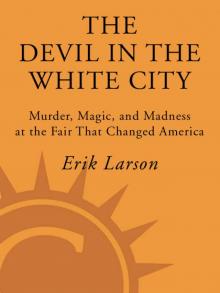- Home
- Erik Larson
Thunderstruck Page 9
Thunderstruck Read online
Page 9
MARCONI HOPED TO SEND messages across all nine miles of the Bristol Channel, but first he planned a more modest trial: to telegraph between Lavernock Point on the Wales side and a tiny island in the channel called Flat Holm, some 3.3 miles away. On Friday, May 7, Kemp traveled by tug to the island carrying a transmitter and took lodging “at a small house owned by the person in charge of the Cremation House.”
Slaby arrived at Lavernock. Generously, if unwisely, Marconi sent a small transmitter to Slaby so that he could monitor the experiments firsthand.
On Thursday, May 13, one week after the tests began, Marconi keyed the message, “So be it, let it be so.”
The sparks generated by his transmitter jabbed the air. Those present had to cover their ears against the miniature thunder of each blue discharge. The resulting chains of waves raced over the channel at the speed of light, from Flat Holm to Lavernock, where Marconi’s main receiver now captured them without distortion.
Slaby realized how much the kaiser would value this new information. Slaby adored Wilhelm. In a letter to Preece, he would write, in unpolished English, “I can’t love him more than I [do], he is the best and loveliest monarch who ever sit on a throne with the deepest understanding for the progress of his time. More than ever I regret, that those horrid politics have made him a stranger to your countrymen and to your whole country, that he is loving so very deeply.”
But this adoration transformed Slaby from neutral academic into de facto spy. In Berlin Slaby had been experimenting on his own with coherers and induction coils to generate electromagnetic waves. He knew the fundamentals, but now he took detailed notes on how Marconi had designed, built, and assembled his apparatus. There can be little doubt that if Marconi had known just how much detail Slaby had harvested, he would have barred him from the tests, but apparently he was too deeply engrossed to notice.
More messages followed.
“It is cold here and the wind is up.”
“How are you?”
“Go to bed.”
“Go to tea.”
And of course, this early example of wireless humor, possibly the first: “Go to Hull.”
Next Marconi tried sending signals all the way across the channel. Though barely legible, they did reach the opposite bank nine miles away, a new record. To Slaby, such a distance seemed incomprehensible. “I had not been able to telegraph more than one hundred meters through the air,” Slaby wrote. “It was at once clear to me that Marconi must have added something else—something new—to what was already known.”
After the experiments Slaby returned quickly to Germany. He was back in Berlin within two days and immediately wrote to Preece to thank him for arranging his visit. “I came as a stranger and was received like a friend and experienced once more, that people may be separated by politics and newspapers but that science unites them.”
Marconi did not share these warm feelings. Just as Preece felt betrayed by Marconi, Marconi now felt betrayed by Preece, for inviting Slaby to witness the experiments. Outwardly, however, he and Preece appeared still to be allies. With post office help Marconi continued his experiments, and Preece prepared for his talk at the Royal Institution, one of the most anticipated lectures in London.
In Berlin, Slaby immediately got to work replicating Marconi’s equipment.
IN LIVERPOOL OLIVER LODGE roused himself from his dalliances with X-rays and ghosts. Angered by the attention being heaped upon Marconi, and by Preece’s patronage, he hired his own attorney. On May 10, 1897, he filed an application to patent a means of tuning wireless transmissions so that signals sent from one transmitter would not interfere with those from another. In the same application he sought also to patent his own coherer and a tapping device that automatically thumped the coherer after each transmission to return its filings to their nonconductive state.
He had to withdraw these last two claims, however. Marconi’s patent had priority.
This did nothing to quell Lodge’s mounting resentment; nor did the news that Preece now planned a lecture on Marconi’s wireless telegraphy at the Royal Institution. For Lodge, it was too much. On Saturday, May 29, 1897, he wrote to Preece to remind him of his own Royal Institution lecture three years earlier:
“The papers seem to treat the Marconi method as all new. Of course you know better, [and] so long as my scientific confreres are well informed it matters but little what the public press says.
“The stress of business may however have caused you to forget some of the details published by me in 1894. I used brass filings in vacuo then too. It could all have been done 3 years ago had I known that it was regarded as a commercially important desideratum. I had the automatic tapping-back [and] everything.”
PREECE WENT AHEAD with his lecture at the Royal Institution. He and Marconi included a demonstration similar to what they had done at Toynbee Hall, with bells “ringing merrily” from refuse cans, as The Electrician put it. The journal called the experiments “wizard-like.”
Preece told the audience, “The distance to which signals have been sent is remarkable,” and added, “we have by no means reached the limit.” Here he aimed an attack at Oliver Lodge. Without identifying Lodge by name, Preece alluded to Lodge’s declaration of three years earlier that Hertzian waves probably could not travel farther than half a mile. “It is interesting to read the surmises of others,” Preece said. “Half a mile was the wildest dream.”
Here, as The Electrician reported, Preece “scored an effective hit.”
At the close of his lecture great applause rose from the audience. From Lodge and the Maxwellians came more fury. In a striking breach of the decorum that governed Victorian science, Lodge took his anger public. In a letter to The Times he wrote, “It appears that many persons suppose that the method of signaling across space by means of Hertzian waves received by a Branly tube of filings is a new discovery made by Signor Marconi. It is well known to physicists, and perhaps the public may be willing to share the information, that I myself showed what was essentially the same plan of signaling in 1894.” He complained that “much of the language indulged in during the last few months by writers of popular articles on the subject about ‘Marconi waves,’ ‘important discoveries’ and ‘brilliant novelties’ has been more than usually absurd.”
The attack startled even his friend and fellow physicist George FitzGerald, though FitzGerald shared Lodge’s opinion. Shortly after the Times letter appeared, FitzGerald wrote to Lodge and cautioned, “It would be important to keep it from becoming a personal question between you and Marconi. The public don’t care about that and will only say, ‘This is a personal squabble: let them settle it amongst themselves.’”
FitzGerald did not blame Marconi. “This young chap himself, I understand he is merely 20”—actually, he was twenty-three—“deserves a great deal of credit for his persistency, enthusiasm, and pluck and must be really a very clever young fellow and it would be very hard to expect him to be quite judicial in his views as to everybody’s credit in the matter.” Marconi had not been “very open,” he wrote, “but he is hardly to blame if his head is a bit swelled under the circumstances, and no Italian or other foreigner was ever really fair in their judgments so that it is quite unreasonable to expect them to be so.”
The real problem was Preece, FitzGerald charged. He urged that Lodge focus his attacks on him, in particular on how Preece and the post office—“absurdly ignorant, as usual”—had ignored the scientific discoveries on which Marconi had based his apparatus and instead had been seduced by a “secret box.”
He added, “Preece is, I think, distinctly and intentionally scoffing at scientific men and deserves severe rebuke.”
ON JULY 2, 1897, MARCONI received his full, formal patent and, without Preece’s knowledge, moved steadily closer to join with Jameson Davis to form a new company.
Preece may have believed he had stymied this plan. In a letter to superiors on July 15, in which he argued the time had come to consider acquiring the patent rights to Marconi
’s system, he wrote: “I have distinctly told him that as he has submitted his scheme to the consideration of the Post Office, the Admiralty and the War Department, he cannot morally enter into any negotiation with anyone else or listen to any financial proposals which might lead to a species of ‘blackmailing’ of his principal, if not his only, customers. He accepts and recognizes this position.”
Preece recommended the government pay a mere £10,000 for the patent rights—about $1.1 million today—and doubted Marconi would feel himself in a position to argue. “It must be remembered that Mr. Marconi is a very young man…. He is a foreigner. He has proved himself to be open and candid and he has resisted very tempting offers. He has very little experience. On the other hand he cannot do much without our assistance and his system can scarcely be made practical for telegraphy by any one in this country but by ourselves.”
But just five days later Marconi founded his new company. His representatives registered its name as the Wireless Telegraph and Signal Co. and identified its headquarters as being in London. Jameson Davis became managing director, with the understanding that once the enterprise was well established he would resign. Marconi received sixty thousand shares of stock valued at one pound each, representing 60 percent ownership of the company. He also received the £15,000 cash, and the company’s pledge to spend another £25,000 developing the technology.
Within six months, the value of Marconi’s stock tripled and suddenly his sixty thousand shares were worth £180,000 pounds, about $20 million today. At twenty-three years of age, he was both famous and rich.
IN BERLIN ADOLF SLABY had been busy. On June 17, one month after witnessing the Bristol Channel experiments, he wrote to Preece, “I have now constructed the whole apparatus of M[onsieur] Marconi and it works quite well. After returning from my holidays, which I intend to spend at the sea shore, I will try to signal through some distance. I feel always indebted to your extreme kindness in remembering those very pleasant and interesting days at Lavernock.”
But Slaby’s warm thanks belied grander ambitions, both for himself and for Germany. Soon he and two associates would begin marketing their own system and, with the enthusiastic backing of the kaiser and a cadre of powerful German investors, would become locked in a shadow war with Marconi that embodied the animosities then gaining sway in the larger world.
For the moment, however, Slaby pretended that all that mattered was science and knowledge. He wrote to Preece, “We are happy men, that we need not care for politics. The friendship that science had made cannot be disturbed and I wish to repeat to you the truest feelings of my heart.”
BRUCE MILLER
BRUCE MILLER HAD ONCE BEEN a prizefighter and had the handsome but battered features to prove it. He had given up boxing for the stage and had come to England some months before meeting Belle in hopes of making a career in variety. He was, literally, a one-man band, playing drums, harmonica, and banjo all at the same time, and performed in London and in the provinces, at Southend-on-Sea, Weston-super-Mare, and elsewhere. When he met Belle, however, he was preparing to leave for Paris and the Paris Exposition of 1900, where he had entered into a partnership involving certain “attractions” at the exposition. He met her one evening in December 1899, about a month after Crippen’s departure for Philadelphia. He was sharing an apartment with a male roommate, an American music teacher, on Torrington Square in Bloomsbury, adjacent to University College. That evening Belle came to the apartment to have dinner with his roommate, who introduced them. On that occasion, Miller said, “I merely shook hands with her and went away.”
They met again, perhaps with Miller’s roommate as intermediary, and became friends. Belle clearly was drawn to his size and rugged good looks. Miller was attracted by her energy and buoyancy and by her lush sexuality. He had a wife back in America, whom he had married in 1886, but as far as he was concerned the marriage had failed and he was married in name only.
“I cannot say that I told Belle Elmore that I was married,” Miller conceded later, “but if I kept it from her it was not done intentionally. I never had anything to hide, or any object in keeping the information from her. When I first came to England I was separated from my wife. She wrote to me pleading to go back and live with her, and I showed Belle Elmore the letters.” Belle agreed he should return to America and rejoin his wife.
Belle was not exactly forthcoming about her own marriage. “When I first met her, she was introduced to me as a Miss Belle Elmore,” Miller said. “I met her several times before I knew that she was married. She frequently spoke of Dr. Crippen, and finally roused my curiosity, and I asked her who was Dr. Crippen?”
“That,” she said, “is my husband. Didn’t your friend tell you I was married?”
With Crippen away in America, Miller began coming to the apartment on Guildford Street two or three times a week, “sometimes in the afternoons,” he said, “and sometimes in the evenings,” though he contended later that the only room he entered was the front parlor.
He began calling Belle “brown eyes.” He gave her photographs of himself, one of which she propped on the piano in the apartment. They went out together often, to restaurants popular with the theatrical crowd, like Jones’s and Pinoli’s, Kettner’s in Soho, the Trocadero—the “Troc”—and most charismatic and infamous of all, the Café Royal on Regent near Piccadilly Circus, frequented by George Bernard Shaw, G. K. Chesterton, the sex researcher Havelock Ellis, the sex-obsessed Frank Harris, and before his fall the sexually indiscreet Oscar Wilde; here one Lady de Bathe, known best as Lillie Langtry, was said to have launched ice cream down the back of Edward, the future king. (Only partly true, as it happens—the incident did occur, but at a different place, and it involved a different actress.) Bookies mingled with barristers and ordered such drinks of the day as the Alabazan, the Bosom Caressa, Lemon Squash, and the Old Chum’s Reviver.
For Bruce Miller and Belle, however, the drink of choice was champagne, and to commemorate their encounters they marked the date on each cork, until they had a string of them, which Belle kept in her possession. “Anything we do is always satisfactory to my husband,” she told Miller. “I always tell him everything.”
By the time Crippen returned, Miller was in Paris. He wrote to Belle “often enough to be sociable, to be friends.” Crippen never met Miller, but Belle made sure he knew more than perhaps he wished. She continued to display at least one photograph of Miller in their home. In March 1901 she sent him an envelope containing six photographs of herself and told him they were taken by Crippen “with his Kodak.” She hinted that Crippen knew she was sending them.
At one point, either by accident or by Belle’s design, Crippen came across letters from Miller that closed with the line, “with love and kisses to Brown Eyes.”
The letters induced in the little doctor a feeling akin to grief.
LATER, MILLER WOULD BE ASKED at length about these letters and about the true meaning of those closing words.
ENEMIES
DESPITE THE CITY’S ENDORSEMENT OF MARCONI, opposition elsewhere gained momentum, led as always by Oliver Lodge but now joined by new allies.
In September 1897 Britain’s most influential electrical journal, The Electrician, came just short of accusing Marconi of stealing Lodge’s work. “In fact Dr. Lodge published enough three years ago to enable the most simple-minded ‘practician’ to compound a system of practical telegraphy without deviating a single hair’s breadth from Lodgian methods.” Returning to Marconi’s patent, the journal sniffed, “It is reputed to be easy enough for a clever lawyer to drive a coach and four through an Act of Parliament. If this patent be upheld in the courts of law it will be seen that it is equally easy for an eminent patent-counsel to compile a valid patent from the publicly described and exhibited products of another man’s brain.”
Meanwhile the public appeared to grow impatient with Marconi’s secrecy and his failure to convert his technology into a practical system of telegraphy, despite reports of his succ
esses at the post office, Salisbury Plain, and the Bristol Channel. This was an age that had come to expect progress. “What we want to know is the truth about all these questionable successes,” one reader wrote in a letter published by The Electrician. “I say questionable, because this delay, this hanging fire, as regards practical results, raises in my mind certain doubts which in common probably with others I should like to have dispelled.
“Wherein are the present difficulties? Are they in the transmitter, in the receiver, or in the intervening and innocent ether, or do they exist in the financial syndicate, who upon the strength of hidden experiments and worthless newspaper reports, have embarked in this great and mysterious venture?”
Once Marconi could have counted on William Preece and the post office to come to his defense, but by now Preece had turned against him—though Marconi seemed oblivious to the change and to the danger it posed. In early September 1897, for example, the post office abruptly barred Marconi from tests it was conducting at Dover, even though the tests involved Marconi’s equipment. Marconi complained to Preece that if he were not allowed to be present, the tests likely would fail. He feared that in the hands of others his wireless would not perform at its maximum; he also knew that the post office’s engineers had not incorporated his latest improvements. He was twenty-three years old, Preece sixty-three, yet Marconi wrote as if chiding a schoolboy: “I hope this new attitude will not be continued, as otherwise very serious injury may be done to my Company in the event of the non success of the Dover experiments.”
Shortly afterward he hired George Kemp away from the post office and made him his personal assistant, one of the most important hiring decisions he would make.
So far all this had taken place out of public view, but early in 1898 the post office exhibited what appeared to be the first official manifestation of Preece’s disenchantment. The postmaster-general’s annual report for the twelve months ended March 31, 1898, disclosed that tests of Marconi’s apparatus had been conducted, “but no practical results have yet been achieved.”

 Lethal Passage: The Story of a Gun
Lethal Passage: The Story of a Gun In the Garden of Beasts: Love, Terror, and an American Family in Hitler's Berlin
In the Garden of Beasts: Love, Terror, and an American Family in Hitler's Berlin Dead Wake: The Last Crossing of the Lusitania
Dead Wake: The Last Crossing of the Lusitania The Splendid and the Vile
The Splendid and the Vile Thunderstruck
Thunderstruck Isaac's Storm: A Man, a Time, and the Deadliest Hurricane in History
Isaac's Storm: A Man, a Time, and the Deadliest Hurricane in History In the Garden of Beasts
In the Garden of Beasts The Devil in the White City
The Devil in the White City